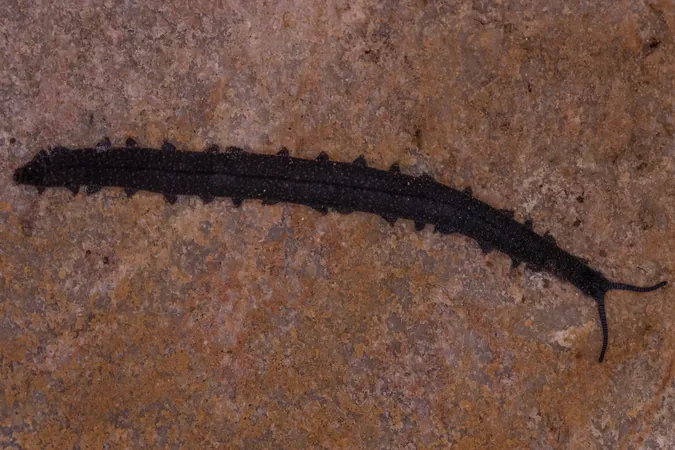
Unveiling a Living Fossil: New Velvet Worm Species Discovered in the Karoo
2025-05-28
Author: Arjun
In a groundbreaking discovery, Stellenbosch University student Rohan Barnard stumbled upon something extraordinary while exploring a farm in the Swartberg Mountains of South Africa. During a routine search for insects and reptiles, he uncovered a rare slate-black velvet worm, which he naively collected and shared on the biodiversity app, iNaturalist.
With a solid background in the unique biology of velvet worms, Barnard had previously assisted his brother in gathering specimens for a zoology project. Little did he know, his find would lead to the identification of a brand-new species, now scientifically named Peripatopsis barnardi, or Barnard's velvet worm.
A Glimpse into the Past: The Majesty of Velvet Worms
Velvet worms are often dubbed 'living fossils,' tracing their lineage back over 500 million years to the Cambrian period. These fascinating creatures, with their soft bodies and non-jointed legs, have seen minimal evolutionary change, making their survival through the millennia an extraordinary tale of resilience.
Barnard’s discovery holds even greater significance, representing the first velvet worm species documented in the little Karoo region, suggesting that the area was once more lush and forested. Climate changes and aridification likely isolated the species, leading to its unique evolutionary path.
The Expert's Insight: Prof. Savel Daniels Weighs In
Prof. Savel Daniels, a leading evolutionary biologist at Stellenbosch University, expressed astonishment over the enduring presence of such ancient lineages. Following Barnard's post on iNaturalist, he visited the site, where he collected additional specimens for further study. Recently, Daniels published findings announcing the discovery of seven new velvet worm species, expanding our understanding of this fascinating group.
"These discoveries reveal that every mountain peak in the Cape Fold Mountains likely hosts an endemic species, hinting at undiscovered biodiversity yet to be explored," he noted. According to Daniels, the region's ancient forest remnants play a crucial role in preserving these unique species.
The Call to Action: Preserve Our Prehistoric Heritage
Both Barnard and Daniels stress the urgent need to protect these ancient habitats. Barnard finds it surreal to have a creature named after him, sharing his hope and concern for the future: "This feels like finding a missing link to a history we barely understand. It inspires me, but also terrifies me at the thought of losing unknown species to extinction."
Why Velvet Worms Matter
Similar to the resilient tardigrades, modern velvet worms represent a unique evolutionary path, emerging independently from ancient marine ancestors. Fossil records indicate that this lineage has persisted relatively unchanged for approximately 540 million years, living in moist environments that once formed part of the ancient supercontinent Gondwana.
As we stand on the brink of potential discoveries, it is clear that there is much at stake—and much to learn—from these prehistoric wonders that continue to thrive in our modern world.





 Brasil (PT)
Brasil (PT)
 Canada (EN)
Canada (EN)
 Chile (ES)
Chile (ES)
 Česko (CS)
Česko (CS)
 대한민국 (KO)
대한민국 (KO)
 España (ES)
España (ES)
 France (FR)
France (FR)
 Hong Kong (EN)
Hong Kong (EN)
 Italia (IT)
Italia (IT)
 日本 (JA)
日本 (JA)
 Magyarország (HU)
Magyarország (HU)
 Norge (NO)
Norge (NO)
 Polska (PL)
Polska (PL)
 Schweiz (DE)
Schweiz (DE)
 Singapore (EN)
Singapore (EN)
 Sverige (SV)
Sverige (SV)
 Suomi (FI)
Suomi (FI)
 Türkiye (TR)
Türkiye (TR)
 الإمارات العربية المتحدة (AR)
الإمارات العربية المتحدة (AR)